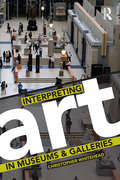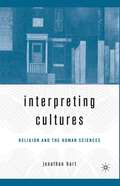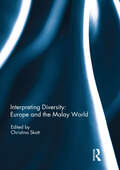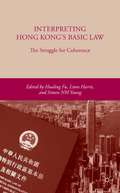- Table View
- List View
Interpreting Archaeology: What Archaeological Discoveries Reveal about the Past
by Neil FaulknerArchaeology can shed light on the rise and fall of empires, the march of technology, the nature of past societies, the development of arts and culture, the course of warfare, and much more. Yet what gives it its greatest value is its ability to illuminate the area in which written records fall short - the everyday lives of ordinary people.Interpreting Archaeology uses a wide array of evidence, including artefacts as varied as humble ceramic pots, imposing monuments, and genetic data, to tell the human story from a new angle.Beginning with the discoveries that have reshaped our understanding of hominin evolution and the spread of Homo sapiens across the globe, Neil Faulkner has charted a fascinating journey through the past, taking in everything from the rise of the world's first great civilizations to the establishment of hierarchies, the development of art and religion, and the causes of warfare along the way.
Interpreting Archaeology: Finding Meaning in the Past
by Ian Hodder Michael Shanks Alexandra Alexandri Victor Buchli John Carman Jonathan Last Gavin LucasThis volume provides a forum for debate between varied approaches to the past. The authors, drawn from Europe, North America, Asia and Australasia, represent many different strands of archaeology. They address the philosophical issues involved in interpretation and a desire among archaeologists to come to terms with their own subjective approaches to the material they study, a recognition of how past researchers have also imposed their own value systems on the evidence which they presented.
Interpreting Art in Museums and Galleries
by Christopher WhiteheadIn this pioneering book, Christopher Whitehead provides an overview and critique of art interpretation practices in museums and galleries. Covering the philosophy and sociology of art, traditions in art history and art display, the psychology of the aesthetic experience and ideas about learning and communication, Whitehead advances major theoretical frameworks for understanding interpretation from curators’ and visitors’ perspectives. Although not a manual, the book is deeply practical. It presents extensively researched European and North American case studies involving interviews with professionals engaged in significant cutting-edge interpretation projects. Finally, it sets out the ethical and political responsibilities of institutions and professionals engaged in art interpretation. Exploring the theoretical and practical dimensions of art interpretation in accessible language, this book covers: The construction of art by museums and galleries, in the form of collections, displays, exhibition and discourse; The historical and political dimensions of art interpretation; The functioning of narrative, categories and chronologies in art displays; Practices, discourses and problems surrounding the interpretation of historical and contemporary art; Visitor experiences and questions of authorship and accessibility; The role of exhibition texts, new interpretive technologies and live interpretation in art museum and gallery contexts. Thoroughly researched with immediately practical applications, Interpreting Art in Museums and Galleries will inform the practices of art curators and those studying the subject.
Interpreting Art in Museums and Galleries
by Christopher WhiteheadIn this pioneering book, Christopher Whitehead provides an overview and critique of art interpretation practices in museums and galleries. Covering the philosophy and sociology of art, traditions in art history and art display, the psychology of the aesthetic experience and ideas about learning and communication, Whitehead advances major theoretical frameworks for understanding interpretation from curators’ and visitors’ perspectives. Although not a manual, the book is deeply practical. It presents extensively researched European and North American case studies involving interviews with professionals engaged in significant cutting-edge interpretation projects. Finally, it sets out the ethical and political responsibilities of institutions and professionals engaged in art interpretation. Exploring the theoretical and practical dimensions of art interpretation in accessible language, this book covers: The construction of art by museums and galleries, in the form of collections, displays, exhibition and discourse; The historical and political dimensions of art interpretation; The functioning of narrative, categories and chronologies in art displays; Practices, discourses and problems surrounding the interpretation of historical and contemporary art; Visitor experiences and questions of authorship and accessibility; The role of exhibition texts, new interpretive technologies and live interpretation in art museum and gallery contexts. Thoroughly researched with immediately practical applications, Interpreting Art in Museums and Galleries will inform the practices of art curators and those studying the subject.
Interpreting As a Discourse Process (Oxford Studies in Sociolinguistics)
by Cynthia B. RoyThis book studies interpreting between languages as a discourse process and as about managing communication between two people who do not speak a common language. Roy examines the turn exchanges of a face-to-face interpreted event in order to offer a definition of interpreted events, describe the process of taking turns with an interpreter, and account for the role of the interpreter in terms of the performance in interaction.
Interpreting Clifford Geertz: Cultural Investigation in the Social Sciences (Cultural Sociology)
by Jeffrey C. Alexander Philip SmithTheorist Clifford Geertz's influence extends far beyond Anthropology. This volume reflects the breadth of his influence, looking at Geertz as a theorist rather than as an anthropologist. To date there has been no impartial, comprehensive, and authoritative work published on this critical figure.
Interpreting Communal Violence in Myanmar
by Nick CheesmanMyanmar’s recovery from half a century of military rule has been fraught. As in other religiously, culturally and linguistically heterogeneous countries where a dictatorship has loosened a tight grip, people there have wanted for democratic institutions to express and manage conflict. Under these circumstances, mundane and seemingly apolitical events sometimes unfold into moments of intense violence. Interpreting Communal Violence in Myanmar addresses one such violent chapter in Myanmar’s recent past: the communal violence that shook the country between 2012 and 2014. The violence, most of it involving Buddhists attacking Muslims, ranged from localised, fleeting, inter-group melees, to large scale, apparently well-organised, state-supported killing and destruction of property of a targeted community, running over a number of days. The book’s seven chapters comprise a response to the violence by a group of Myanmar and Southeast Asia experts. Their contributions trace the histories and contemporary features of the violence, and the legal and political arrangements that made it possible. Their interpretations, while specific to Myanmar, also contribute to broader debate about the characteristics, causes and consequences of communal violence generally. The chapters were originally published as a special issue in the Journal of Contemporary Asia.
Interpreting Communal Violence in Myanmar
by Nick CheesmanMyanmar’s recovery from half a century of military rule has been fraught. As in other religiously, culturally and linguistically heterogeneous countries where a dictatorship has loosened a tight grip, people there have wanted for democratic institutions to express and manage conflict. Under these circumstances, mundane and seemingly apolitical events sometimes unfold into moments of intense violence. Interpreting Communal Violence in Myanmar addresses one such violent chapter in Myanmar’s recent past: the communal violence that shook the country between 2012 and 2014. The violence, most of it involving Buddhists attacking Muslims, ranged from localised, fleeting, inter-group melees, to large scale, apparently well-organised, state-supported killing and destruction of property of a targeted community, running over a number of days. The book’s seven chapters comprise a response to the violence by a group of Myanmar and Southeast Asia experts. Their contributions trace the histories and contemporary features of the violence, and the legal and political arrangements that made it possible. Their interpretations, while specific to Myanmar, also contribute to broader debate about the characteristics, causes and consequences of communal violence generally. The chapters were originally published as a special issue in the Journal of Contemporary Asia.
Interpreting Cultures: Literature, Religion, and the Human Sciences
by J. HartThis book focuses on how we perceive, know and interpret culture across disciplinary boundaries. The study combines theoretical and critical contexts for close readings in culture through discussions of literature, philosophy, history, psychology and visual arts by and about men and women in Europe, the Americas and beyond.
Interpreting Diversity: Europe and the Malay World
by Christina SkottThis volume departs from conventional historiography concerned with colonialism in the Malay world, by turning to the use of knowledge generated by European presence in the region. The aim here is to map the ways in which European observers and scholars interpreted the ethnic, linguistic and cultural diversity which has been seen as a hallmark of Southeast Asia. With a chronological scope of the eighteenth to the early twentieth century, contributors examine not only European writing on the Malay world, but the complex origins of various forms of knowledge, dependent on local agency but always closely intertwined with contemporary metropolitan scientific and scholarly ideas. Knowledge of the peoples, languages and music of the Malay world, it is argued, came to inform and shape European scholarship within a variety of areas, such as Enlightenment science and anthropology, ideas of human progress, philological theory, ethnomusicology and emerging theories of race. But this volume also contributes to ongoing debates within the region, by discussing ideas about the Malay language and definitions of ‘Malayness’. The last chapters of the book present a reversed viewpoint, in examinations of how local cultural forms, theatrical traditions and literature were reshaped and given new meaning through encounters with cosmopolitanism and perceived modernity. This book was previously published as a special issue of Indonesia and the Malay World.
Interpreting Diversity: Europe and the Malay World
by Christina SkottThis volume departs from conventional historiography concerned with colonialism in the Malay world, by turning to the use of knowledge generated by European presence in the region. The aim here is to map the ways in which European observers and scholars interpreted the ethnic, linguistic and cultural diversity which has been seen as a hallmark of Southeast Asia. With a chronological scope of the eighteenth to the early twentieth century, contributors examine not only European writing on the Malay world, but the complex origins of various forms of knowledge, dependent on local agency but always closely intertwined with contemporary metropolitan scientific and scholarly ideas. Knowledge of the peoples, languages and music of the Malay world, it is argued, came to inform and shape European scholarship within a variety of areas, such as Enlightenment science and anthropology, ideas of human progress, philological theory, ethnomusicology and emerging theories of race. But this volume also contributes to ongoing debates within the region, by discussing ideas about the Malay language and definitions of ‘Malayness’. The last chapters of the book present a reversed viewpoint, in examinations of how local cultural forms, theatrical traditions and literature were reshaped and given new meaning through encounters with cosmopolitanism and perceived modernity. This book was previously published as a special issue of Indonesia and the Malay World.
Interpreting Ground-penetrating Radar for Archaeology
by Lawrence B ConyersGround-penetrating radar (GPR) has become one of the standard tools in the archaeologist's array of methods, but users still struggle to understand what the images tell us. In this book—illustrated with over 200 full-color photographs—Lawrence Conyers shows how results of geophysical surveys can test ideas regarding people, history, and cultures, as well as be used to prospect for buried remains. Using 20 years of data from more than 600 GPR surveys in a wide array of settings, Conyers, one of the first archaeological specialists in GPR, provides the consumer of GPR studies with basic information on how the process works. He show how the plots are generated, what subsurface factors influence specific profiles, how the archaeologist can help the surveyor collect optimal data, and how to translate the results into useable archaeological information.
Interpreting Ground-penetrating Radar for Archaeology
by Lawrence B ConyersGround-penetrating radar (GPR) has become one of the standard tools in the archaeologist's array of methods, but users still struggle to understand what the images tell us. In this book—illustrated with over 200 full-color photographs—Lawrence Conyers shows how results of geophysical surveys can test ideas regarding people, history, and cultures, as well as be used to prospect for buried remains. Using 20 years of data from more than 600 GPR surveys in a wide array of settings, Conyers, one of the first archaeological specialists in GPR, provides the consumer of GPR studies with basic information on how the process works. He show how the plots are generated, what subsurface factors influence specific profiles, how the archaeologist can help the surveyor collect optimal data, and how to translate the results into useable archaeological information.
Interpreting Hong Kong’s Basic Law: The Struggle for Coherence
by H. Fu L. Harris S. YoungOn July 1, 2007, Hong Kong celebrated its tenth anniversary as a special administrative region of China. It also marked the first decade of its unique constitutional order in which Hong Kong courts continue to apply and develop the common law but the power of final interpretation of the constitution lies with the Standing Committee of the National People's Congress. This book is a collection of chapters by leading constitutional law experts in Hong Kong who examine the interpretive issues and conflicts which have arisen since 1997. Intervention by China in constitutional interpretation has been restrained but each intervention has had significant political and jurisprudential impact. The authors give varied assessments of the struggle for interpretive coherence in the coming decade.
Interpreting Intersectionality: Interpretative Politics in Metacommentaries (The Feminist Imagination - Europe and Beyond)
by Amund Rake HoffartAgainst the backdrop of the emergence of intersectionality as a dominant paradigm in feminist scholarship and activism, this book explores the genre of metacommentaries as critical responses to the development of intersectionality as a paradigm. With attention to the dispersal of intersectionality into ever-newer contexts – and the missteps and breakdowns that occur during this process – it addresses the concern that intersectionality is transforming into something unrecognisable, drifting too far away from its foundational sources and visions and becoming diluted by its expansion. Examining the process by which metacommentaries engage in a form of corrective storytelling – seeking to rescue intersectionality from misuse by pinning it down and returning it to where it belongs – Interpreting Intersectionality presents a critique of these gestures of correction, arguing that, far from reconnecting intersectionality with its roots and enabling it to realise its potential, such metacommentaries actually bind the scholarly discourse on intersectionality to an either/or argumentative dynamic. It will therefore appeal to scholars and students with an interest in feminist theory, gender studies and/or intersectional analysis.
Interpreting Intersectionality: Interpretative Politics in Metacommentaries (The Feminist Imagination - Europe and Beyond)
by Amund Rake HoffartAgainst the backdrop of the emergence of intersectionality as a dominant paradigm in feminist scholarship and activism, this book explores the genre of metacommentaries as critical responses to the development of intersectionality as a paradigm. With attention to the dispersal of intersectionality into ever-newer contexts – and the missteps and breakdowns that occur during this process – it addresses the concern that intersectionality is transforming into something unrecognisable, drifting too far away from its foundational sources and visions and becoming diluted by its expansion. Examining the process by which metacommentaries engage in a form of corrective storytelling – seeking to rescue intersectionality from misuse by pinning it down and returning it to where it belongs – Interpreting Intersectionality presents a critique of these gestures of correction, arguing that, far from reconnecting intersectionality with its roots and enabling it to realise its potential, such metacommentaries actually bind the scholarly discourse on intersectionality to an either/or argumentative dynamic. It will therefore appeal to scholars and students with an interest in feminist theory, gender studies and/or intersectional analysis.
Interpreting Interviews
by Mats AlvessonThrough the use of eight original metaphors for understanding what may happen in interviews and what may guide the interviewee (more than telling the truth or revealing experiences), the reader is encouraged to do interviews in clever ways. This text enables you to question the interpretive nature and theoretical underpinnings of the interview method, and of the knowledge which is conveyed through it. The updated second edition includes new content on: • How to avoid traps in interviews • How to use interviewees with experience and insight • How to work creatively with generative material • The value of repeat interviewing over time • The importance of supplementing interviews with other methods • Possibilities of interview-based research accompanied by examples This text is essential reading for upper undergraduate and postgraduate students of qualitative methods, and researchers looking to more clearly conceptualize their interviewing practice and explore its theoretical basis. Mats Alvesson is professor at University of Bath and is also affiliated with Lund University, Stockholm School of Economics and Bayes Business School.
Interpreting Interviews
by Mats AlvessonThrough the use of eight original metaphors for understanding what may happen in interviews and what may guide the interviewee (more than telling the truth or revealing experiences), the reader is encouraged to do interviews in clever ways. This text enables you to question the interpretive nature and theoretical underpinnings of the interview method, and of the knowledge which is conveyed through it. The updated second edition includes new content on: • How to avoid traps in interviews • How to use interviewees with experience and insight • How to work creatively with generative material • The value of repeat interviewing over time • The importance of supplementing interviews with other methods • Possibilities of interview-based research accompanied by examples This text is essential reading for upper undergraduate and postgraduate students of qualitative methods, and researchers looking to more clearly conceptualize their interviewing practice and explore its theoretical basis. Mats Alvesson is professor at University of Bath and is also affiliated with Lund University, Stockholm School of Economics and Bayes Business School.
Interpreting Interviews
by Mats AlvessonThrough the use of eight original metaphors for understanding what may happen in interviews and what may guide the interviewee (more than telling the truth or revealing experiences), the reader is encouraged to do interviews in clever ways. This text enables you to question the interpretive nature and theoretical underpinnings of the interview method, and of the knowledge which is conveyed through it. The updated second edition includes new content on: • How to avoid traps in interviews • How to use interviewees with experience and insight • How to work creatively with generative material • The value of repeat interviewing over time • The importance of supplementing interviews with other methods • Possibilities of interview-based research accompanied by examples This text is essential reading for upper undergraduate and postgraduate students of qualitative methods, and researchers looking to more clearly conceptualize their interviewing practice and explore its theoretical basis. Mats Alvesson is professor at University of Bath and is also affiliated with Lund University, Stockholm School of Economics and Bayes Business School.
Interpreting Islam, Modernity, and Women’s Rights in Pakistan
by A. WeissIn Pakistan, myriad constituencies are grappling with reinterpreting women's rights. This book analyzes the Government of Pakistan's construction of an understanding of what constitutes women's rights, moves on to address traditional views and contemporary popular opinion on women's rights, and then focuses on three very different groups' perceptions of women's rights: progressive women's organizations as represented by the Aurat Foundation and Shirkat Gah; orthodox Islamist views as represented by the Jama'at-i-Islami, the MMA government in Khyber Pakhtunkhwa (2002-08) and al-Huda; and the Swat Taliban. Author Anita M. Weiss analyzes the resultant "culture wars" that are visibly ripping the country apart, as groups talk past one another - each confidant that they are the proprietors of culture and interpreters of religion while others are misrepresenting it.
Interpreting Islamic Political Parties
by M. SalihInterpreting Islamic Political Parties offer a critical analysis and explanation of the evolution, institutionalization and current developments of Islamic political parties. The volume contains case studies of Islamic political parties in Algeria, Egypt, Indonesia, Kuwait, Lebanon, Malaysia, Maldives, Mauritius, Somalia, South Africa and Sudan.
Interpreting Japan: Approaches and Applications for the Classroom
by Brian J. McVeighWritten by an experienced teacher and scholar, this book offers university students a handy "how to" guide for interpreting Japanese society and conducting their own research. Stressing the importance of an interdisciplinary approach, Brian McVeigh lays out practical and understandable research approaches in a systematic fashion to demonstrate how, with the right conceptual tools and enough bibliographical sources, Japanese society can be productively analyzed from a distance. In concise chapters, these approaches are applied to a whole range of topics: from the aesthetics of street culture; the philosophical import of sci-fi anime; how the state distributes wealth; welfare policies; the impact of official policies on gender relations; updated spiritual traditions; why manners are so important; kinship structures; corporate culture; class; schooling; self-presentation; visual culture; to the subtleties of Japanese grammar.? Examples from popular culture, daily life, and historical events are used to illustrate and highlight the color, dynamism, and diversity of Japanese society.? Designed for both beginning and more advanced students, this book is intended not just for Japanese studies but for cross-cultural comparison and to demonstrate how social scientists craft their scholarship.?
Interpreting Japan: Approaches and Applications for the Classroom
by Brian J. McVeighWritten by an experienced teacher and scholar, this book offers university students a handy "how to" guide for interpreting Japanese society and conducting their own research. Stressing the importance of an interdisciplinary approach, Brian McVeigh lays out practical and understandable research approaches in a systematic fashion to demonstrate how, with the right conceptual tools and enough bibliographical sources, Japanese society can be productively analyzed from a distance. In concise chapters, these approaches are applied to a whole range of topics: from the aesthetics of street culture; the philosophical import of sci-fi anime; how the state distributes wealth; welfare policies; the impact of official policies on gender relations; updated spiritual traditions; why manners are so important; kinship structures; corporate culture; class; schooling; self-presentation; visual culture; to the subtleties of Japanese grammar.? Examples from popular culture, daily life, and historical events are used to illustrate and highlight the color, dynamism, and diversity of Japanese society.? Designed for both beginning and more advanced students, this book is intended not just for Japanese studies but for cross-cultural comparison and to demonstrate how social scientists craft their scholarship.?
Interpreting Japanese Society: Anthropological Approaches
by Joy HendryFirst published in 1986, Interpreting Japanese Society became something of a classic in the field. In this newly revised and updated edition, the value of anthropological approaches to help understand an ancient and complex nation is clearly demonstrated.While living and working in Japan the contributors have studied important areas of society. Religion, ritual, leisure, family and social relations are covered as are Japanese preconceptions of time and space - often so different from Western concepts.This new edition of Interpreting Japanese Society shows what an important contribution research in such a rapidly changing industralised nation can make to the subject of anthropology. It will be welcomed by students and scholars alike who wish to find refreshing new insights on one of the world's most fascinating societies.
Interpreting Japanese Society: Anthropological Approaches
by Joy HendryFirst published in 1986, Interpreting Japanese Society became something of a classic in the field. In this newly revised and updated edition, the value of anthropological approaches to help understand an ancient and complex nation is clearly demonstrated.While living and working in Japan the contributors have studied important areas of society. Religion, ritual, leisure, family and social relations are covered as are Japanese preconceptions of time and space - often so different from Western concepts.This new edition of Interpreting Japanese Society shows what an important contribution research in such a rapidly changing industralised nation can make to the subject of anthropology. It will be welcomed by students and scholars alike who wish to find refreshing new insights on one of the world's most fascinating societies.















